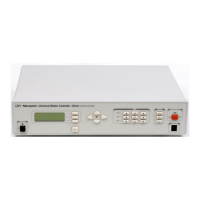PID Loop
The third term of the PID Loop is the derivative term. It is defined as
the difference between the following error of the current servo cycle
and of the previous one. If the following error does not change, the
derivative term is zero.
(
Figure 5.16) shows the PID servo loop diagram. The derivative term
is added to the proportional and integral one. All three process the
following error in their own way and, added together, form the control
signal.
The derivative term adds a damping effect that prevents oscillations
and position overshoot.
Figure 5.16: PID Loop
Trajectory
Generator
Motion Controller
Servo Controller
Driver
Motor
Encoder
Kp
Ki
∫ e
Kd
de
dt
e
5.3.2 Feed-Forward Loops
As described in the previous paragraph, the main driving force in a
PID loop is the proportional term. The other two correct static and
dynamic errors associated with the closed loop.
Taking a closer look at the desired and actual motion parameters and
at the characteristics of the DC motors, some interesting observations
can be made. For a constant load, the velocity of a DC motor is
approximately proportional with the voltage. This means that for a
trapezoidal velocity profile, for instance, the motor voltage will have
also a trapezoidal shape (
Figure 5.17).
The second observation is that the desired velocity is calculated by the
trajectory generator and is known ahead of time. The obvious
conclusion is that we could take this velocity information, scale it by
K
vff
factor and feed it to the motor driver. If the scaling is done
properly, the right amount of voltage is sent to the motor to get the
desired velocities, without the need for a closed loop.
5-16 Section 5 – Motion Control Tutorial

